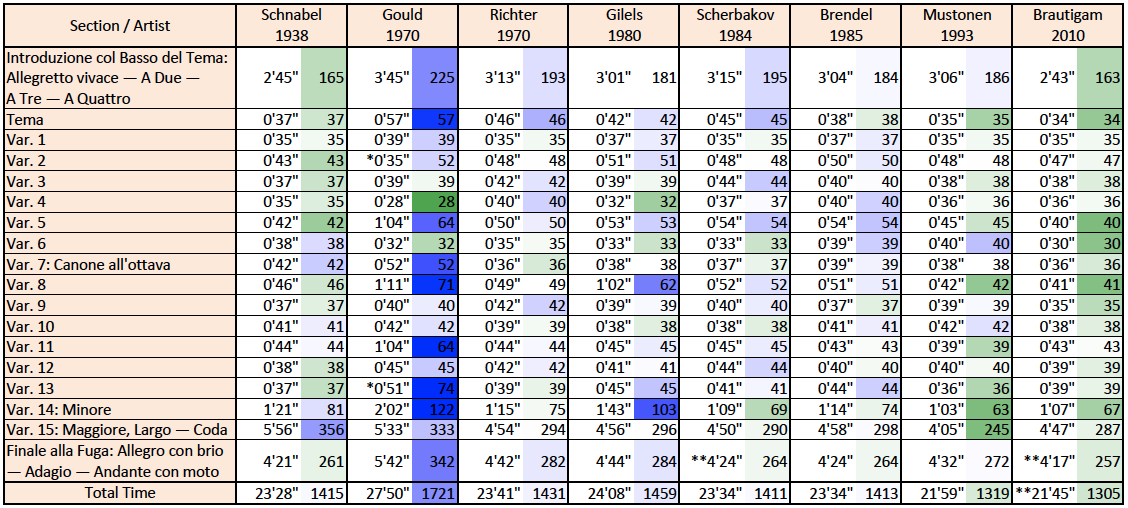Ludwig van Beethoven
15 Variations with a Fugue in E♭ major, op.35, “Eroica”
Media Review / Comparison
2012-08-13 — Original posting (on Blogger)
2013-08-02 — New standard layout applied
2014-11-04 — Re-posting as is (WordPress)
2015-08-08 — Added Konstantin Scherbakov
2016-07-07 — Brushed up for better readability
Table of Contents
The Recordings in the Comparison
After the note on the Beethoven Piano Variations WoO 71, this is another “intermezzo” on recordings of the 15 Variations with a Fugue for piano in E♭ major, op.35, by Ludwig van Beethoven (1770 – 1827), the so-called “Eroica” Variations. Here are the recordings that I listened to:
- Artur Schnabel (1938)
- Glenn Gould (1970)
- Svjatoslav Richter (1970)
- Emil Gilels (1980)
- Konstantin Scherbakov (1984)
- Alfred Brendel (1985)
- Olli Mustonen (1993)
- Ronald Brautigam (2010)
A Timing Comparison
In the chart below I have listed the partial / track durations (in min/sec, and in seconds) for these artists. No rating is intended with this. I have marked the “seconds” value for those tracks in blue which are slower than the average, whereas green markings stand for tracks that are shorter / faster than the average. All parts are in 2/4 time, except for Variation 15 (Maggiore, Largo — Coda), which is written in 6/8 time.
Remarks
- Glenn Gould’s recording falls out of the traditional scheme (much more than fortepiano recordings from conventional ones on modern pianos). Therefore, the average track duration (used for the coloring scheme) was calculated without including Glenn Gould’s recording.
- (*) these tracks are variations where Glenn Gould omits the repetition of the second part; with the addition of a second repetition, variation 2 would be 0’52”, variation 13 would be 1’14”.
- (**): without the trailing silence.
The Recordings, Compared
Below are my comments on these recordings. Note that with the addition of Scherbakov’s recording, I have also made minor adjustments to the rating of other interpretations (namely Richter and Gilels, which are the primary ones that I compared Scherbakov with).
Artur Schnabel (1938)
Ludwig van Beethoven: Piano Works, volume 10 — Variations opp.34 & 35; Bagatelles op.33; Fantasia op.77; Bagatelle WoO 59 (“Für Elise”); Rondo in A WoO 49; Minuet in E♭, WoO 82
Naxos 8.110764 (CD, mono); ℗ / © 2005
Booklet: 6 pp. (English)

Artur Schnabel (1882 – 1951) recorded the “Eroica”-Variations in 1938, along with the variations op.34 and various other works (see above).
On the Artist
Schnabel maybe was the most uncompromising pianist of his time. After meticulously studying the score, he developed a dramatic concept that — as he felt — most accurately matches the composer’s intent. Essentially he ignored limitations in the mechanics and acoustics of the instrument (or the recording technique?), as well as limitations in his own technique. The result is an often very dramatic interpretation. with rapid passages clearly becoming inaccurate, partly also inaudible, “washed out”. He does not play rubato overall (as many pianists of that time would have done), apart from some ritardandi. But he often makes strong variations in tempo within bars or short phrases, typically “rushing” fast notes and ornaments — just as it fits into his concept.
Remarks on the Performance
Variation 1 is very fast, but almost swinging, others (like 2, 4, or parts of the fugue) appear simply rushed. #13 exceeds the limitations of the mechanics of a modern concert grand (or is it lack of articulation?). #15 (Maggiore, Largo, 6/8) is very slow, to a degree which makes it impossible to gather the rhythm. The first half (and the Coda) feel like senza misura. The first variation is following the theme without break, thereafter, Schnabel plays the variations as individual pieces, each with its own character & dramatic concept. The breaks between the variations are short, but still, he does not make an attempt to present the composition as one single, big phrase / movement.
| Recommendation: | More of historic interest than real listening pleasure, compared to current interpretations. |
| Rating: | 2.9 / 5 (17 tracks) |
Glenn Gould (1974)
Ludwig van Beethoven: Variations, opp.34 & 35; 32 Variations in C minor, WoO 80; Bagatelles op.33 & 126
Glenn Gould (1974)
Sony classical SM2K 52 646 (2 CDs, stereo); ℗ 1970 – 1992 / © 1992
Booklet: 24 pp. (en/dr/fr/it)

Glenn Gould (1932 – 1982) recorded the “Eroica”-Variations in 1970, along with the variations op.34, the 32 variations WoO 80, and two sets of Bagatelles (see above).
On the Artist
The key to understanding this interpretation is in the fact that Glenn Gould did not understand himself as simply the interpreter (the conveyor) of a composer’s work. He thought of himself as a composer (which to a good degree he was, as well as a writer and brilliant thinker). In essence, one should take his interpretation as “what he would have meant / intended with a given work, had this been his own composition”. I’m just trying to explain, I don’t mean to criticize his attitude here. In a way, this is the key to most of his many interpretations. With this in mind, one can not expect anything close to a “standard” performance—not here, nor when he performs Bach or works of other composers.
One should also note that in his restless, brilliant mind, his own interpretation / concept with a given piece was never fixed, but heavily evolving over the 35+ years of his career. There is a huge contrast between his first “official” recording of Bach’s Goldberg variations from 1955 (where he presented a series of brilliant, pianistic, but individual pieces), and the final one from 1982 (which I like much more), where the focus is on showing an ensemble of consecutive, constantly evolving, and tightly connected variations that make this composition sound like one single, long, but multifaceted movement under one single rhythmic “bracket”. Indeed, one can hear / experience this recording as one single, big emotional phrase.
Remarks on the Performance
I see these “Eroica” variations as laying somewhere between the two extremes of Gould’s “Goldberg” recordings just mentioned (from 1955 and 1982). It neither has the pianistic congeniality of the early Goldbergs, nor does it feature the compelling evolution, the big phrase / bracket of the late Goldbergs. I have somewhat mixed feelings about this interpretation; here are some remarks on the recording:
Details — Introduzione:
- The “Introduzione col Basso del Tema” is annotated “Allegretto vivace” (2/4). Gould definitely does not play Allegretto, let alone vivace. His tempo is about 1/4 = 72 — Andante at best. The half-notes in bars 2 – 5 are staccato, too (all others play them legato, except for Gilels who does them tenuto). The last bass note in the second part of the introduction is doubled (the score shows this as option).
- I’m not sure why this sounds so dull, almost out of tune: limitations in the recording technique? That’s hard to believe with Gould’s perfectionism!
- The three variations of that introduction (a due —a tre — a quattro) are of course equally slow, and Gould plays them detached, as individual, detached little pieces, rather than as seamless progression from unison to higher complexity.
Details — Theme and Variations 1 – 7:
- Also the theme itself is not Allegretto, but sounds like a rather dull peasant dance. The second repetition is played with an extreme rallentando, even though there’s just a fermata.
- Variation 1 is very rigid, devoid of any flexibility in the tempo, the beginning is rather clumsy; also variation 3 sounds like an Etude. Variations 1 – 3 are played together, almost attacca.
- The second part of variation 2 features a free cadenza (Presto) , but this really is not the type of final cadenza in a concert movement that leads into the Coda. It is just a short excursion leading to the ending phrase of that variation, and the second part also has repeat signs. Gould forms the entire second part into a single, big cadenza. Consequently, playing the repetition no longer makes sense. This puts this variation “out of balance” compared to most others.
- #4 is pianistically very nice, and very fast (the only one where he is the fastest of the players). However, I think there’s way too much focus on the fast sixteenth movement, played almost staccato. The following variation 5 forms an extreme contrast, being rather contemplative, played at half the tempo of the preceding one. Variation 6 is back to the fast tempo of variation 4.
- #7 (Canone all’ottava) is played attacca (as composed), but sounds rather slow, static, stiff, rigid, not playful.
Details — Variations 8 – 15, Fugue:
- Variation 8 sounds nice, but puts too much focus / emphasis on the sixteenths part, which really ought to be accompaniment; it is the slowest of all interpretations here.
- #10 is played attacca after 9, but not free of mannerism. Even more so variation 11: very stiff, rigid, like an Etude, “ex cathedra”.
- #13 is loud, slow, sometimes stiff / rigid — and Gould omits the second repetition.
- #14 (minore) is extremely slow — even though there is no tempo annotation. Gould freely (partly) anticipates the Largo from the following, last variation 15 (Maggiore). As an isolated pair, 14 and 15 may make sense this way, but it certainly does not match the dramatic concept laid out in the score. In the beginning of variation 15, Gould uses arpeggio almost throughout. Also, in Gould’s hands, that last variation is very “loaded”, almost like a movement from one of Beethoven’s last piano sonatas. Gould appears to be maybe lost in details. Yes, it’s a very “rich” interpretation, but is that adequate in this context?
- In the fugue, Gould gets carried away, “teaching how to write a fugue”. It does feel like a teaching exercise, slow, often stiff / rigid. For parts of that section , this “works”, but towards the end of the first part it almost becomes a bit obnoxious. In the Andante con moto section, he gets lost in details completely, putting too much focus on the accompanying voices, exaggerated phrasing. Also, it is unclear to me why he decided to play explicit (i.e., demisemiquavers) trills at the beginning of the last section. Maybe because he detests the virtuoso aspect of playing continuous trills together with two independent voices?
Summary:
As stated before: there are some interesting aspects / moments / sequences in Gould’s interpretation of this set of variations. But overall, I don’t think Gould “succeeded”: I wish he had progressed to the kind of view that he applied to the final recording of the Bach Goldberg variations; his interpretation “falls apart”, lacks the compelling, continuous evolution towards the fugue.
| Recommendation: | If you are a member of the Glenn Gould community / fan club you will (want to) have this recording anyway. For the others: I don’t think these variations show Gould at his best, plus, it can hardly be compared with any of the other recordings, old & new, see above. If you are looking for one recording of these variations, I would not pick this interpretation. |
| Rating: | 2.6 / 5 (17 tracks) |
Svjatoslav Richter (1970)
Ludwig van Beethoven: Piano Variations opp. 34, 35 (“Eroica”), 76
Robert Schumann: Novelletten Nr.2, 4, and 8 from op.21
Alto (Amazon MP3 download, 230 – 238 kbps)
Booklet: none with download

Svjatoslav Richter (1915 – 1997) recorded these variations in 1970. They were originally published on LP, together with the variations op.34 and op.76. I have this in my LP collection. It took me a while to find a digital version that I could download. For the CD & MP3 download release, the Schumann Novellettes No. 2, 4, and 8 from op.21 were added in.
Remarks on the Performance
Along with Gilels, this is one of the “classic” interpretations of op.35 (in my LP collection, I just had Richter and Schnabel). With the exception of the fugue, all variations are played attacca (mostly not “binding over”, though, but with a very short break).
Details — Theme and Variations:
- The theme (after the introduction) sounds rather clumsy (clumsier than with Gilels). I would find this appropriate to differentiate a theme by another composer — but this is Beethoven’s own material! Richter’s piano touch is sometimes on the hard side — or was the instrument in bad shape?
- In contrast to the theme, the first variations are rather fast, as if Richter wanted to differentiate the variations from the theme.
- Richter is technically excellent; one thing that differentiates his playing from Gilels’ is that he tends to use more pedal.
- Variation 7 is brilliant, very clear.
- In variation 8, Richter extends Beethoven’s pedaling annotation almost to the entire variation, which makes this sound rather soft, “cloudy”.
- In variation 15 (Maggiore, Largo) there is more than enough pedal — some parts sound extremely soft — can’t reach Gilels’ interpretation.
| Recommendation: | Among the two “classic” interpretations, my slight preference goes to Gilels rather than Richter. This preference may be caused / influenced by my preference for the fortepiano and historically informed playing. Compared to Gilels, this sounds “slightly older”… |
| Rating: | 3.6 / 5 (17 tracks) |
Emil Gilels (1980)
Ludwig van Beethoven: Sonatas
DG 00289 477 6360 (9 CDs, stereo); ℗ / © 1996
Booklet: 16 pp. (en/de/fr)

Emil Gilels (1916 – 1985) recorded these variations in 1980. They were published together with the (incomplete) collection of the Beethoven piano sonatas (the only non-sonata piece in this collection).
Remarks on the Performance
Within this selection, Gilels’ and Richter’s interpretations are the “conventional” ones (conventional in the sense of the second half of the 20th century). Within that range, Gilels’ recording is definitely excellent overall. Unlike Schnabel (and even more so Gould), his focus is on the big phrases, the overall evolution throughout the composition. Many of the variations are strung together: 1 – 5, 6 – 7, 8 – 13. Yet, Gilels does not try to link all (or most) variations through a common base beat. There are points where Gilels “breaks the evolution”, though he is still trying to perform this as one big composition, using tempo changes as component in his overall dramatic concept.
Details — Introduzione:
In the introduction, the “a due” etc. sections are faster than the beginning. But then, Gilels makes almost extreme ritardandi for the fermatas and the Poco adagio. The theme itself is on the slow side (though of course not nearly as slow as with Gould), almost clumsy. Strangely, bars 5 and 6 appear faster, slightly rushed, for no obvious reason;
Details — Theme and Variations:
- Variations such as 2, 3, and 4 are pianistically excellent, brilliant even, given the “modest context” of a (albeit easily underestimated) set of variations;
- #5 is definitely on the slow side, falls “out of context”. It breaks the drive that was developing in the preceding variations;
- #11 nicely exhibits joking aspects in Beethoven’s composition.
- #14 (Minore) is on the slow side (there is no tempo annotation!). Maybe it is a bit too tragic, almost as if it was a part of one of Beethoven’s late piano sonatas.
- With some pianists, Variation 15 (Largo) has a tendency to “fall apart”. The theme is very slow, in 6/8, accompanied by a constantly changing / evolving ornamentation. Gilels’ interpretation is superb, in that it not only keeps this variation together in one big, dramatic evolution, but it also makes the listener experience the 6/8 measures and the underlying theme.
| Recommendation: | Certainly one of the great, classic interpretations. If you are not into historically informed playing and/or prefer not to experiment with “unusual” interpretations, I can really recommend this! |
| Rating: | 3.9 / 5 (19 tracks) |
Konstantin Scherbakov (1984)
Ludwig van Beethoven: 15 Variations op.35 (“Eroica”), Piano Sonatas opp.13 & 57
Konstantin Scherbakov, piano (1984)
Two Pianists Records TP1039190 (5 CDs, stereo); ℗ / © 2015
Booklet: 12 pp. (English)

For general comments on Konstantin Scherbakov (*1963) see the post “Piano Recital Konstantin Scherbakov, 2015-03-24“.
On the Recording
These variations were played in the concert I’m referring to in “Piano Recital Konstantin Scherbakov, 2015-03-24“. However, note that the variations on this CD were recorded back in 1984 (while the two sonatas on the same CD were recorded in 2014). In other words: these variations were recorded when the artist was 21. That’s one year after he won the first Rachmaninoff Competition in Moscow in 1983—his international concert and recording career only really took off around 1990. I have added this CD “after the fact”, 3 years after the original posting which compared 7 recordings. Given that this recording pre-dates the concert by over 30 years, I decided not to take into consideration my impressions from the concert. I merely do a direct comparison with existing recordings in my collection.
Details — Introduzione:
In the Introduzione, this is a very considerate interpretation, at a moderate tempo, never pushing — to the contrary: in his agogics, Scherbakov often uses slight ritardandi in order to leave enough “room” for details, ornaments. The articulation is very detailed, almost meticulous, formal parts are kept (subtly) separated, i.e., double bar lines and repeat signs are audible. Thish keeps the structure clear. Overall, the tempo is more consistent in the Introduzione than with Gilels.
Details — Theme and Variations 1 – 7:
- In the tema, the first four bars (quavers) are played slightly slower / heavier than the subsequent bars in semiquavers. That’s obviously not by accident or neglect, but done consciously. The effect is similar to Gilels’ interpretation, though with the Scherbakov the first bars appear slower, whereas with Gilels, the following bars appear slightly rushed. Overall (everything being relative), this seems identical, though I think it is not.
- Scherbakov takes the first variation slightly faster than the tema, but maintains the same “tempo structure”, by keeping the first four bars a tad slower than the rest. He focuses on “structural” / agogic continuity rather than continuity by sticking to the same tempo.
- Variation 2 is excellent — in my opinion better than Gilels and Richter, with extremely balanced piano touch, clear, no or very little extra pedal. Also in variation 3, Scherbakov uses less pedal than Gilels.
- #4 is of unusual formal and pianistic clarity — clearer (and a tad slower), but slightly less emotional than Gilels.
- #5: like Gilels, Scherbakov takes back the tempo, but not quite to the same degree. It forms somewhat of a resting point, though without really disrupting the sequence.
- #7 (Canone all’ottava) is again exceptionally clear — among the best that I know, along with Richter in this case.
Details — Variations 8 – 15, Fugue:
- Variation 8: very lyrical and singing, expressive — more than Gilels and Richter
- #11: pianistically as clear as Schnabel and Gilels, but with more humor (especially compared to Gilels), with “joking agogics” — excellent!
- #13: again clearer, and yet less dry than Gilels. It’s close to Richter, though with a softer, more balanced piano touch (or a better instrument?)
- #14: interesting — here, Scherbakov is among the fastest, along with Mustonen and Brautigam. His interpretation definitely makes sense, especially considering that Beethoven did not add any tempo annotation
- #15 & Fugue: maybe with slightly less analytic depth than Gilels. On the other hand, Scherbakov plays with a softer touch and a warmer tone. It is more “integrative”, more focused on maintaining the flow, the “big arch”, while keeping the excellent & detailed articulation. Definitely among the best interpretations imaginable.
Overall — this confirms my conclusion from the piano recital on 2015-03-24: clearly an excellent exponent of the great Russian piano school. Scherbakov avoids extremes, is technically flawless — a strong interpretation, indeed! I now understand why the artist preferred this early performance over re-recording the variations. He probably felt that his early benchmark recording is hard to beat. Many thanks to the artist for digging this up!
| Recommendation: | A lucid, compelling, classic interpretation — I even prefer it over Gilels — definitely worth a strong recommendation! |
| Rating: | 4.1 / 5 (17 tracks) |
Alfred Brendel (1985)
Ludwig van Beethoven: Variations, op.35; Bagatelles, op.126; 6 Ecossaises, WoO 83
Alfred Brendel, piano (1985)
Decca (Amazon MP3 download, stereo, 173 – 230 kbps)
Booklet: none with download

Alfred Brendel (*1931) recorded these variations in 1985, along with the Bagatelles op.126, the Bagatelle “Für Elise”, and the 6 Ecossaises WoO 83.
On the Artist
Alfred Brendel is often said to be an “intellectual” musician. This is an attribute that is impossible to “quantify”. One may even view or (ab)use it as derogatory statement in the context of concert critiques. One should therefore use it with care. The same would hold true for a statement about a hypothetical “anti-intellectual” musical attitude. In classical music, performing artists need a fair amount of understanding of musical notation, musical structures, musical conventions, and the common understanding and perception of music at the time of creation of a composition — there is no such thing as “playing without intellect”.
On the other hand, one can argue that some artists may use their intellect to learn, understand and memorize a piece, but during a concert performance they are entirely focusing on the emotional content. Then, there may indeed be artists who keep doing the same level of intellectual work also during a performance. In this case, they may be reinventing / rethinking the interpretation every time. Or they may at least intellectually and actively control every aspect of an interpretation while performing. I would claim that Glenn Gould falls into this latter category (sometimes to his detriment, as in this particular piece). There are (in my opinion) indeed signs that Brendel is “in the same camp”, at least to some degree.
Remarks on the Performance
One danger of “intellectual playing” may be in the trap that the artist starts thinking whether anybody else is playing a passage the very same way, possibly making this a “duplicate” of someone else’s interpretation. This sheer thought — be it spontaneous, during a performance, or systematic, in preparing for a performance — may lead to odd choices, “quirky” phrasing or articulation, etc.
Ideally, I think artists should play what they feel/think is “right”, irrespective of what others are playing: the result will be much more convincing.
Details — Introduzione:
One possible example for such a situation is in the section “a due” in the “Introduzione col Basso del Tema“, where bar #13 features two fermata notes, one on E♭ and a second one on D, separated by a little ornament, and followed by a short chromatic scale. After the first fermata, the bar is annotated Poco adagio (the following bar is a tempo). Every single interpretation I know plays out the two fermata notes — Brendel only leaves a minute trace of the second fermata notation — why? Is Brendel scared of exhibiting excessive romanticisms? There are other examples in this piece where Brendel appears to try avoiding fermatas. The staccati in the A quattro section are at the border of mannerism. One could say the same about Brendel’s agogics in the tema.
Details — Theme and Variations:
- Throughout the variations (e.g., in variation 1), there are examples of (somewhat) capricious articulation, agogics & phrasing (ritardandi, extra sforzati, even syncopated ones, etc.).
- In variation 4, most pianists focus on the theme (staccato) in the right hand, using the sixteenths in the left hand to demonstrate their virtuosity. Brendel carefully articulates the left hand, as if it was the main melody, while just hinting at the theme in the right hand.
- Variations 4 – 6 are rather slow; also in variation 6, Brendel avoids showing off virtuosity in the left hand.
- In variation 10, Brendel theatrically slows down the sixteenth alterations in bars #10 and #12, hereby also avoiding a real ff.
- The second part of variation 13 for me is rather loud, almost ranting, boisterous — too loud?
- On the bright side, variation 14 (Minore) nicely alludes / relates to the preceding variation. Unlike other pianists, Brendel does not (mis)interpret the minor key as sad and/or slow.
- The fugue is very transparent & clear — a good interpretation!
| Recommendation: | Not bad, but certainly not my favorite interpretation. |
| Rating: | 3.3 / 5 (15 tracks) |
Olli Mustonen (1993)
Ludwig van Beethoven: Piano Variations
Decca / iTunes download (256 kbps, Decca); ℗ 1993
Booklet: none with download

Olli Mustonen (*1967) caught my attention when I listened through recordings of the Beethoven piano concertos. I downloaded this CD via iTunes: it was released in 1993 and features the piano variations op. 34 (F major), op.35 (E♭ major, “Eroica” Variations), WoO 69-71, and 78-80. The variations op.35 were recorded (or released) in 1993.
On the Artist
Olli Mustonen is an exceptional pianist — and fairly unique in the classical music scene: he is also composer and conductor, and already in his early recording he exhibits a very unique articulation (especially what I would call “rapid Mustonen-staccato“), making the concert grand gain new colors, sometimes approaching the richness of a fortepiano (all performances by Mustonen that I listened to so far are from the classical period). I can only think of two other pianists having / using similarly special articulation — Glenn Gould (see above) and Andrew Tyson (Web site under development). The latter I have only really heard in broadcasts from the 2010 Chopin competition in Warsaw — with Chopin exclusively, obviously (there he reminded me of Horowitz playing Scarlatti sonatas!).
Gould goes beyond Mustonen in many ways. Both are (& probably think like) composers, but their attitude towards Beethoven is very much different: Gould completely dissects the music in an effort to explain / show / demonstrate what he thinks is the structure, the content of a composition, i.e., what he sees in a composition — as a composer (see again above). Mustonen’s articulation is “analytic” in a way, too — but I feel that he uses that to express the composer’s (perceived) intent on the concert grand.
Remarks on the Performance
Unlike Gould, he isn’t always analytic, “scientific” and scholarly, but very much amenable to the joking, playful aspects in many of Beethoven’s compositions. There are certainly musical jokes, witty sections in this set of variations!
General Observations
- Throughout this piece one can hear what I meant with “rapid Mustonen-staccato“: in many rapid sixteenth passages, Mustonen makes the fast notes sound like staccato. They may not be played staccato in reality, it’s just his special, masterful articulation!
- Sometimes he may appear to “break the rules” by using such articulation for semiquavers under a bow. However, classical notation does not really differentiate between slurs (implying a legato) and phrase marks. Mustonen often takes as phrase marks what others interpret as slur (one example is in variation 10): we can’t ask the composer for the true meaning; to me, Mustonen’s interpretation makes at least as much sense as the “conventional” one.
- Pretty much in general, Mustonen’s biggest focus is on small scale “diction” / articulation, rather than on lyrical, big phrases. His mental presence is phenomenal: there’s nothing superficial in his interpretation, and his sharp, rapid and accurately placed accents are stunning!
- That said, Mustonen connects all variations (plus the introduction, the theme and the final fugue) by playing attacca (without any break). The only and very few general pauses in this interpretation are where Beethoven explicitly composed them.
- He also connects the theme and all variations (except for variation 15, Largo) by (almost) a single, common beat / tempo.
- Quite frequently, Mustonen explores the limitations of the mechanics of a concert grand (examples: variations 3, 13), playing rapidly repeats such that the “successor beat” hits the string in full sound.
Details
- Already the first chord (E♭, ff, fermata) in this piece is stunning: Mustonen holds that chord for a full 12 seconds. The sound is not gone by then, but it molds perfectly into the following pp notes!
- In my opinion, this is the only interpretation (in this comparison) that really does justice to the (main) theme. It is by far the best interpretation of these 16 bars, unlike, e.g., the rather clumsy interpretations by Richter and Gilels. After the evolving introduction with its three “pre-variations” on the bass of the theme, in Mustonen’s hands the theme blossoms up, showing off its real qualities. It’s for good reason that Beethoven has used this theme in four compositions (i.e., also in Nr.7 from “12 Contretänze”, WoO 14, in “Die Geschöpfe des Prometheus”, op.43, and in the Symphony Nr.3, op.55, “Eroica”).
- A nice example of his staccato is in variation 4, in the very virtuoso semiquavers in the left hand. However, despite all focus on the left hand articulation, that voice remains accompaniment, the theme (staccato chords in the right hand) retains its role.
| Recommendation: | Even though it doesn’t quite feature the same qualities and the rich sound of a period instrument, this recording features at least as much depth / range in expression as Brautigam’s. I think it’s simply excellent, and I would not want to miss it! Yes, a strong recommendation! |
| Rating: | 5.0 / 5 (17 segments) |
Ronald Brautigam (2010)
Ludwig van Beethoven: Complete Works for Solo Piano, Volume 11: Variations WoO 71-73; Variations WoO 75-77; Variations op.35 (“Eroica”)
Ronald Brautigam, fortepiano (2010)
BIS BIS-SACD-1673 (SACD stereo + surround, CD stereo); ℗ 2011 / © 2012
Booklet: 32 pp. (en/de/fr)

Ronald Brautigam (*1954) recorded this CD in 2010, as part 11 of his project “Beethoven, Complete Works for Solo Piano”. Apart from op.35, the recording also features WoO 71, 72, 73, 75, 76, and 77. He plays the “Eroica” variations on a fortepiano after Conrad Graf, from around 1819, by Paul McNulty (2007). I have written about Ronald Brautigam playing Beethoven in several posts (Bagatelle “Lustig und Traurig”, WoO 54, 12 Variations for piano, WoO 71, and the Listening Diary 2012-07-28). I will therefore keep these comments short.
Remarks on the Performance
In general, I prefer Brautigam’s Walter-fortepiano over the one used here. However, I still think it is stunning how much additional color Brautigam can achieve con this instrument, compared to a modern concert grand. The sound is so much more transparent and differentiated! It makes most modern interpretations (with the exception of Mustonen’s, see above) sound (almost) boring! As adequate for the instrument with its lighter sound and articulation, Brautigam uses faster tempi: 8 out of 18 segments are substantially faster than the average of the interpretations discussed here. None is slower than the average.
The big advantage of using a fortepiano is that the artists does not need to put nearly as much effort into achieving transparency and differentiated articulation as Mustonen. The instrument appears to permit achieving that effortlessly, almost automatically. Of course, Brautigam is one of the few real masters of this instrument, so one should not underestimate the artist’s contribution. Brautigam does use attacca (legato even, i.e., without any break) where he sees fit (1 – 3, 5/6, 8/9, 11 – 13), but he does not enforce a direct connection throughout. Instead, he is among the most consequent among the pianists here in keeping a similar pace throughout the variations, up to and including variation 14. His key focus is on short and large scale phrasing and evolution — a very nice interpretation!
| Recommendation: | YES, definitely / strongly! |
| Rating: | 5.0 / 5 (17 segments) |
Conclusion
Once more, I can’t make up my mind between Mustonen and Brautigam. Both are excellent and very worthwhile listening to! For the “conventional” approach, my slight preference (over Richter) goes to Gilels.

















